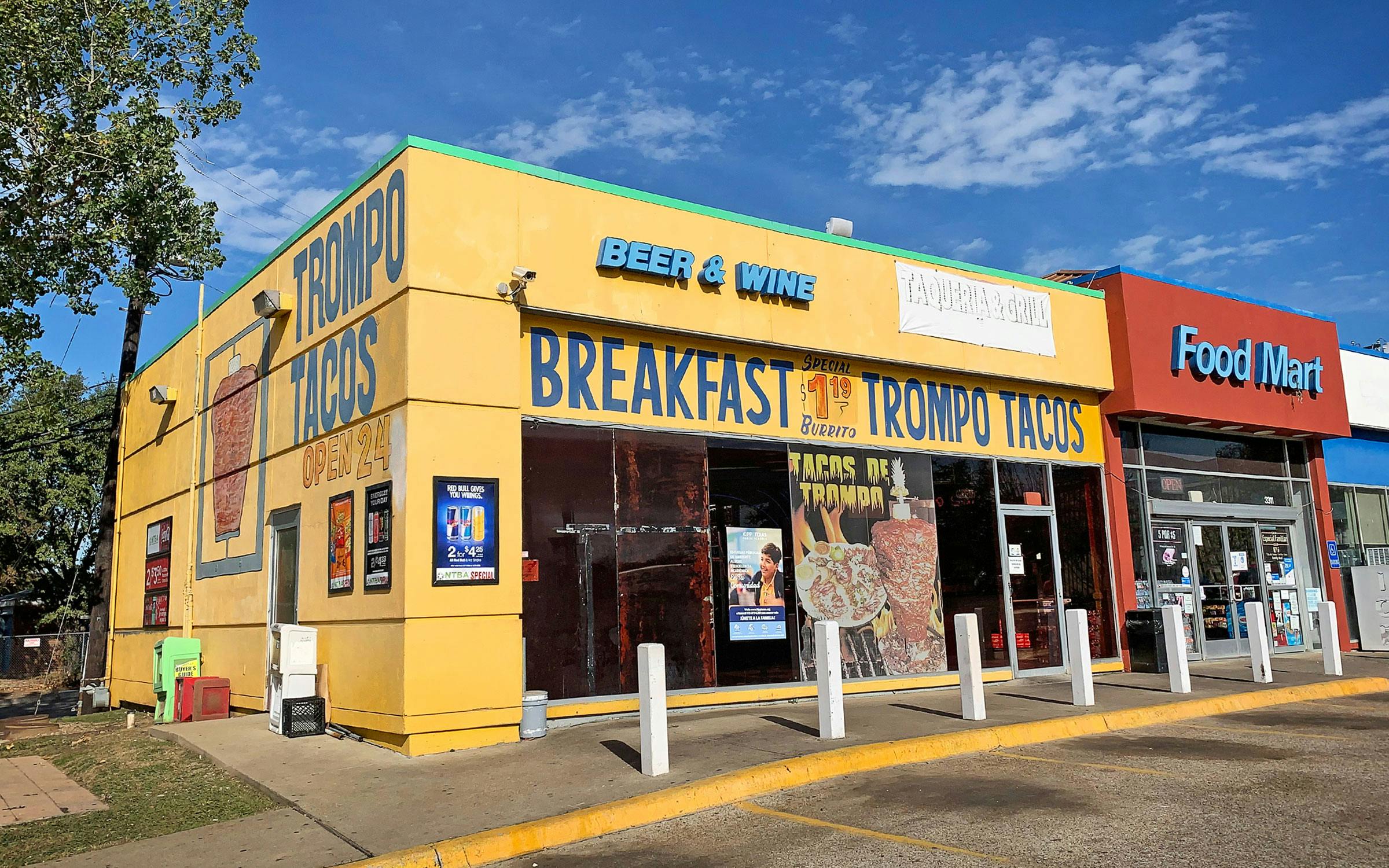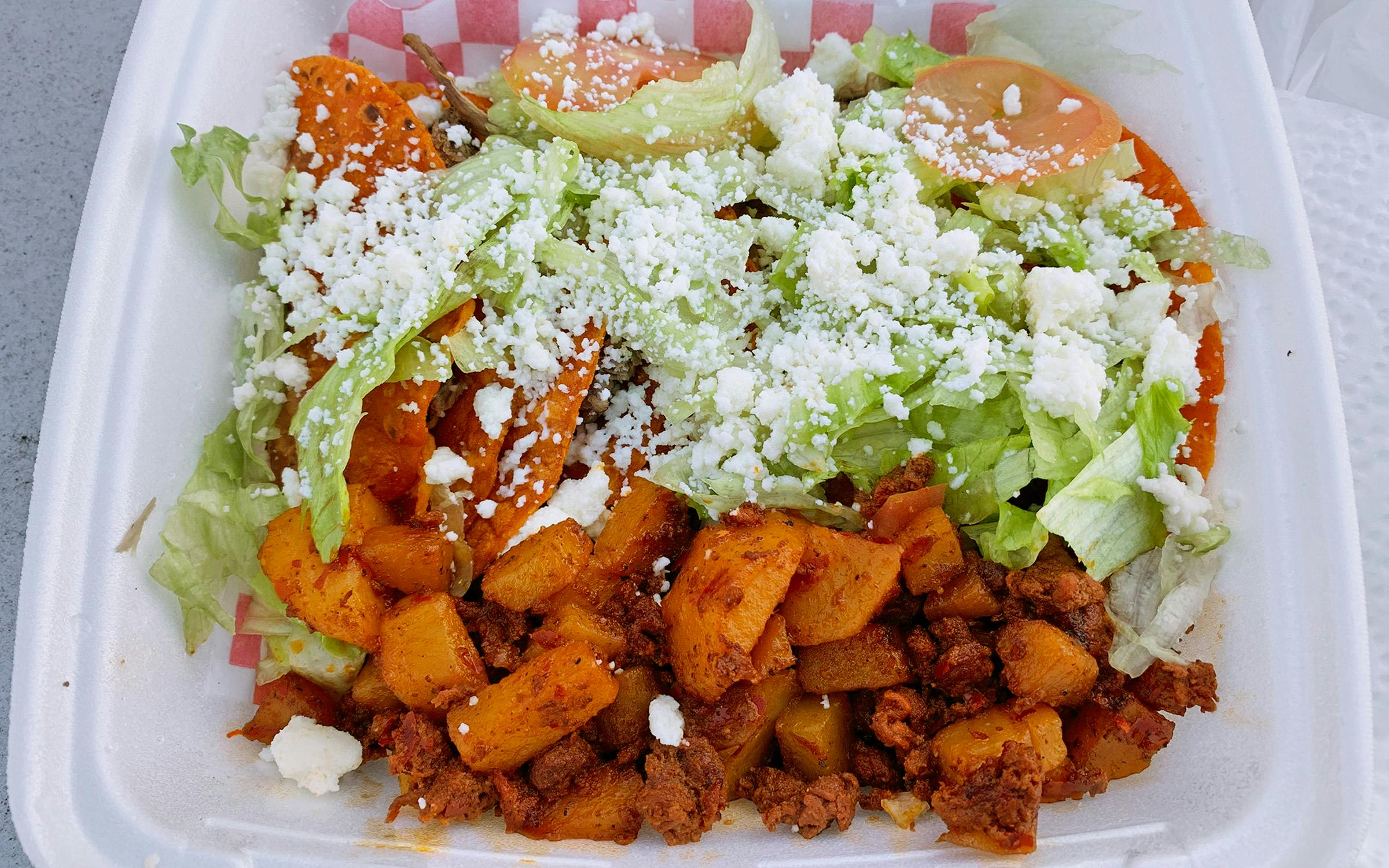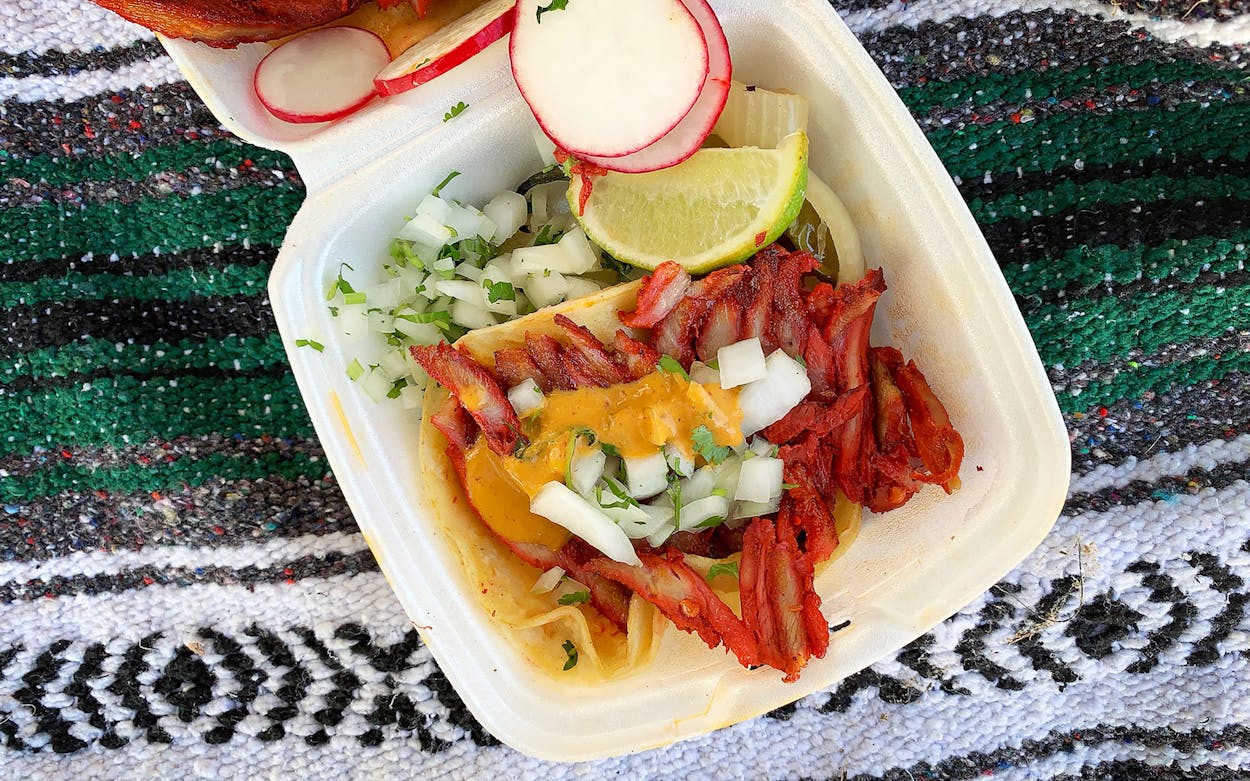The red, white, and blue neon signs bearing the words Fuel City Wash shine 24 hours a day. They are visible as you cross the Jefferson Boulevard Viaduct or zip through the massive, braided interchanges of interstates 30 and 35 from downtown Dallas into the Oak Cliff neighborhood. Fuel City is a gas station and car wash, but its sprawling complex has a theme park vibe. Passing drivers often slow down to stare at the menagerie in the on-site zoo, whose residents have included longhorns, zebras, and bison. A statue of a Sasquatch stands in a field, and a closed swimming pool is guarded by a dinosaur. At one point, the store even hosted karaoke on Fridays and Saturdays.
Fuel City is best known, however, for its tacos. Tourists, office workers, those who just posted bail at the nearby jail, and late-night partygoers all line up to order them at sliding-glass windows. The air is infused with the aromas of gasoline, grease, and exhaust. In my opinion, these tacos are overhyped and overrated. Fuel City has also been part of a media narrative that assumes that gas-station tacos are a unique category, a specific style on par with tacos de trompo or Korean tacos. This is simply false. You can find all kinds of tacos in or near gas stations—including plenty of good ones—but they vary just as widely as tacos anywhere. To lump them into one category is misleading and unhelpful.
One of the earliest mentions of gas station tacos was in a November 1997 edition of the McAllen Monitor. In her ode to traveling between McAllen and Austin, deputy metro editor Pamela Coleman anointed the now shuttered Garza’s truck stop in the small town of George West, about two hours north of McAllen, as serving the best “gas station tacos.”
But the concept really took hold in 2006, when Texas Monthly named Fuel City’s picadillo as the state’s best taco. The story sparked an online backlash, including criticism from yours truly. Texas Monthly’s acknowledgement also put Dallas on the state and national taco map, and helped to launch the idea of gas station tacos. In 2011, the Wall Street Journal subtly cited Texas Monthly’s christening of Fuel City as an influence on a taco trend it dubbed “Texaco-Mex.” CNN profiled Fuel City in 2012, and a year later, Thrillist included it in a roundup of “Dallas’s best gas station tacos.” The idea that gas station tacos are a trend, and one with roots in North Texas, has persisted. The 2016 book The Tacos of Texas described the region as a gas-station taco mecca, and this year Irving’s convention and visitors bureau released its own list.

All this hype ignores the fact that there is no codified genre of gas station tacos. Tacos, like most foods, can be made almost anywhere a person can set up a grill, fryer, or griddle and a wash station. Just because there are a plethora of taco operations in gas stations, or in food trucks in gas station parking lots, doesn’t make them a thing.
To understand how widely tacos sold in or near gas stations can vary, consider a few stellar examples. In West Dallas, Speedy Tacos is a walk-up taqueria that makes excellent taquitos rojos estilo San Luis Potosí: six chile-permeated corn tortillas filled with stewed strings of beef served folded and loaded with crisp lettuce, tomato slices, queso fresco, chorizo, and cubed potatoes that have taken on some of the red chorizo’s color. The chile de árbol salsa is fiery and the salsa verde is tart.
Contrast that with Bachman Tacos & Grill, which operates out of a Chevron on Northwest Highway in North Dallas. A giant painting of a trompo, or vertical rotisserie spit, beckons customers, usually area workers who pay at the convenience store register before handing the receipt to the taquero behind the high counter. The trompo tacos are bright and punchy, freshened up with chopped raw white onions and cilantro and a side of pale orange salsa de chile de árbol. A third example is Taqueria Poblana in Bryan, where the juicy granules of beef chorizo and crispy slices of al pastor warranted two mentions in our “Ultimate Texas Tacopedia.”

In South Austin, brightly painted and lit trailer La Tunita 512 peddles in luscious chunks of chile-imbued stewed brisket birria. While there are several options, perhaps the best is the quesotaco, a corn tortilla that nestles beef enveloped in a shimmering Monterey Jack costra. This presentation differs from the standard cheesy birria taco, in which white cheese acts as a stretchy, gooey barrier between the tortilla and the filling.
But in the realm of taquerias in gas stations, there is one operation that has primacy over all others: Laredo Taco Company. I first encountered the South Texas–born gas station taqueria chain in 2013 during a taco excursion to the Rio Grande Valley. Between McAllen and Brownsville, it seemed every other block had a Laredo Taco Company inside a Stripes gas station convenience store. The friend I was with insisted that I try the taqueria’s breakfast tacos of made-to-order flour tortillas and fresh filling options served from steam trays in warming pans. They were fantastic.
The first thing that struck me was the line of customers patiently waiting. More than once, I heard an employee behind the counter tell someone that it would be maybe ten minutes before they had bacon and eggs, and the customer always replied that they would happily wait for the fresh batch. The small pans held a range of egg-based fillings, such as machacado con huevo (a South Texas favorite), and heavier selections, including beef barbacoa. Other pans were filled with individual ingredients for marquee tacos. Among the best is the Q Taco. Named after the Harlingen-based “Q 94.5” radio station, the signature taco begins with a slathering of refried beans, then adds scrambled eggs and cubed potatoes. The beans help keep the eggs and potatoes in place. A liberal dose of shredded cheese slowly melting atop the other ingredients binds the fillings in a long, rolled flour tortilla that’s wrapped in foil.
Twenty-year-old Laredo Taco Company is a fixture of South Texas. Its origins are in the border city of the same name, but it’s synonymous with Corpus Christi–based Stripes stores. In the seven years since I had my first tacos from the gas station taqueria, I’ve watched the chain grow west and north. In 2018, Irving-based 7-Eleven purchased Laredo Taco Company and Stripes, then launched a revamped model that combined the brands. The new iteration is called an “evolution store.” The first such shop opened in my Dallas neighborhood, meaning I no longer have to travel near the Texas-Mexico border to enjoy wonderful breakfast tacos made in a gas station.








